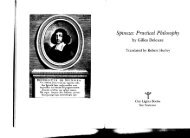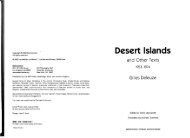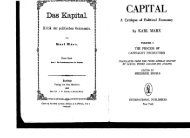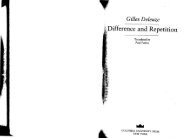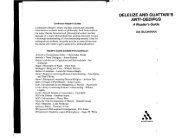Pedagogies - Una Chung
Pedagogies - Una Chung
Pedagogies - Una Chung
- No tags were found...
Create successful ePaper yourself
Turn your PDF publications into a flip-book with our unique Google optimized e-Paper software.
the naming ofplace is somewhat misleading in light ofthe omnipresenceofthe Sacred, since naming implies that the Sacred has been cordoned off,managed, and made partial to a chosen geography, much like the invocationto God to bless America, while presumably leaving the rest of theworld unblessed.Migrations are one indication that these cosmological systems aremarked by anything but stasis. Some energies have been fused; othersapparently atrophy in certain places while becoming dominant in others.Yemaya, the goddess of the Ocean seems to have "disappeared" in Haiti,yet homage to Agwe the sea god and Mambo La Siren, the mermaid sisterof the two Ezilis, Freda Dahomey and Dant(), attest to the sustainedmetaphysical significance of water in both systems. Yemaya reigns inCandombIe and Lucumi, assuming the position that had been accordedher River sister Oshun in Yorubaland, the recognition that it would havebeen impossible to have survived the Crossing without her. Often thereare multiple avatars of the same Sacred force, while collectivities developdifferent relationships to the same multilayered entity as Sacred energiesengage the different inventions of the social. Not paradoxically withinVodou, Lucumi, and Candombh! is retained the manifest energies ofEshufPapa LegbafElegba/Elegbara, guardian of Divine energy and communication,guardian of the crossroads, the force that makes things happen,the codification of potentiality and its indispensable tool, choice,which is multiplied at the crossroads-the place where judicious vigilanceneeds always to be exercised. Still, who is remembered-and how-iscontinually being transformed through a web ofinterpretive systems thatground meaning and imagination in principles that are ancient with anapparent placement in a different time. Yet, both the boundaries of thoseprinciples as well as what lies within are constantly being transformed inthe process of work in the present; collapsing, ultimately, the rigid demarcationof the prescriptive past, present, and future of linear time.Both change and changelessness, then, are constant.Housed in the memory of those enslaved, yet not circumscribed by it,these Sacred energies made the Crossing. But t~ey did not require theCrossing in order to express beingness. They required embodied beingsand all things to come into sentience, but they did not require the Crossing. There was a prior knowing, a different placement in the humanidiom of constricted time. Still, the capacity to operate outside of humantime does not mean that Divine energy has no facility within it. In thissense, there is no absolute transcendence-no transcendence, in fact-forif there were, there would be no intervention in, and no relationshipwith, the material, the quotidian, the very bodies through which divinitybreathes life. Indeed, the Divine knits together the quotidian in a way thatcompels attunement to its vagaries, making this the very process throughwhich we come to know its existence. It is, therefore, the same processthrough which we come to know ourselves, as in the words of Maria, anespiritista: "Yo soy mis santos; mis santos soy yo" (I am my saints; mysaints are me).3 How does one come to know oneself through and asSaints or Spirits? How does one not know oneself without them? Whatkind of labor makes this intelligibility possible?The force of these questions at first came imperceptibly to me,and in quite another guise. In 1989, I had embarked on a project on theways in which African cosmologies and modes of healing became thelocus of an epistemic struggle in nineteenth-century Trinidad, the periodmarking the establishment of the slave plantation economy and the consolidationof the colonial state. My intent was to use an array of documentssurrounding the trial, torture, and execution of Thisbe, one ofthose captured and forced into the Crossing, who was accused of "sorcery,divination and holding frequent converse with the devil." I wanted toshow the ways in which the body had become central in the contestbetween European and African systems: positioned as moveable property-chattel-and as repository of sin, or understood as the direct instrumentof the Divine, mediator between the world of the living and theworld of the dead. I used this approach in order to move beyond themore dominant understanding of African spiritual practice as culturalretention and survival, to get inside of the meaning of the asepistemological, that is, to pry open the terms, symbols, and organizationalcodes that the Bantu-K6ngo people used to make sense of theworld. I had surmised that cosmological systems housed memory, andthat such memory was necessary to distill the psychic traumas producedunder the grotesque conditions of slavery. How, whv, and under what292 CHAPTER 7PEDAGOGIES OF THE SACRED 293




